
Personal protective equipment (PPE) is protective clothing, helmets, goggles, or other garments or equipment designed to protect the wearer's body from injury or infection. The hazards addressed by protective equipment include physical, electrical, heat, chemical, biohazards, and airborne particulate matter. Protective equipment may be worn for job-related occupational safety and health purposes, as well as for sports and other recreational activities. Protective clothing is applied to traditional categories of clothing, and protective gear applies to items such as pads, guards, shields, or masks, and others. PPE suits can be similar in appearance to a cleanroom suit.

A wetsuit is a garment worn to provide thermal protection while wet. It is usually made of foamed neoprene, and is worn by surfers, divers, windsurfers, canoeists, and others engaged in water sports and other activities in or on water. Its purpose is to provide thermal insulation and protection from abrasion, ultraviolet exposure, and stings from marine organisms. It also contributes extra buoyancy. The insulation properties of neoprene foam depend mainly on bubbles of gas enclosed within the material, which reduce its ability to conduct heat. The bubbles also give the wetsuit a low density, providing buoyancy in water.

A cleanroom or clean room is an engineered space that maintains a very low concentration of airborne particulates. It is well isolated, well controlled from contamination, and actively cleansed. Such rooms are commonly needed for scientific research and in industrial production for all nanoscale processes, such as semiconductor manufacturing. A cleanroom is designed to keep everything from dust to airborne organisms or vaporised particles away from it, and so from whatever material is being handled inside it.

A dry suit or drysuit provides the wearer with environmental protection by way of thermal insulation and exclusion of water, and is worn by divers, boaters, water sports enthusiasts, and others who work or play in or near cold or contaminated water. A dry suit normally protects the whole body except the head, hands, and possibly the feet. In hazmat configurations, however, all of these are covered as well.

A zipper, zip, fly, or zip fastener, formerly known as a clasp locker, is a commonly used device for binding together two edges of fabric or other flexible material. Used in clothing, luggage and other bags, camping gear, and many other items, zippers come in a wide range of sizes, shapes, and colors. In 1892, Whitcomb L. Judson, an American inventor from Chicago, patented the original design from which the modern device evolved.
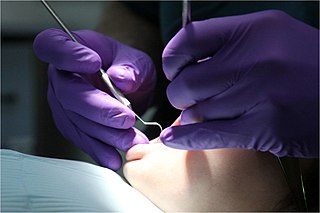
Medical gloves are disposable gloves used during medical examinations and procedures to help prevent cross-contamination between caregivers and patients. Medical gloves are made of different polymers including latex, nitrile rubber, polyvinyl chloride and neoprene; they come unpowdered, or powdered with corn starch to lubricate the gloves, making them easier to put on the hands.

Tyvek is a brand of synthetic flashspun high-density polyethylene fibers. The name "Tyvek" is a registered trademark of the American multinational chemical company DuPont, which discovered and commercialized Tyvek in the late 1950s and early 1960s.
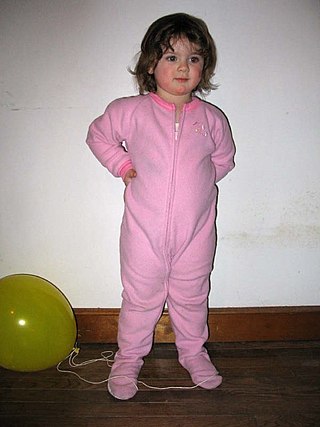
The blanket sleeper is a type of especially warm sleeper or footie pajama worn primarily during the winter in the United States and Canada. The garment is worn especially by young children.

A hazmat suit is a piece of personal protective equipment that consists of an impermeable whole-body garment worn as protection against hazardous materials.
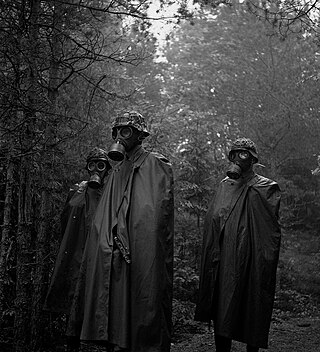
An NBC suit, also called a chem suit, or chemical suit is a type of military personal protective equipment. NBC suits are designed to provide protection against direct contact with and contamination by radioactive, biological, or chemical substances, and provide protection from contamination with radioactive materials and all types of radiation. They are generally designed to be worn for extended periods to allow the wearer to fight while under threat of or under actual nuclear, biological, or chemical attack. The civilian equivalent is the hazmat suit. The term NBC has been replaced by CBRN, with the addition of the new threat of radiological weapons.

A survival suit, more accurately and currently referred to as an immersion suit, is a type of waterproof dry suit intended to protect the wearer from hypothermia if immersed in cold water or otherwise exposed after abandoning a vessel, especially in the open ocean. Immersion suits usually have integral footwear, and a hood, and either built-in gloves or watertight wrist seals. Suits manufactured by several manufacturers also include an inflatable pillow which is permanently attached high on the back, or an inflatable tube that is attached with zippers at two points on the chest, each side of the main zipper, and circles the back. When inflated, both of these devices provide enhanced stability to the wearer, which, if conscious, allows them to keep the head above water, and to keep wind and seas from striking the face. The inflation tube is routed from the inflatable pillow over the left shoulder of the user, and secured in a loop on the chest.

Clothing fetishism or garment fetishism is a sexual fetish that revolves around a fixation upon a particular article or type of clothing, a particular fashion or uniform, or a person dressed in such a style.
This is a list of existing articles related to fashion and clothing. For individual designers, see List of fashion designers
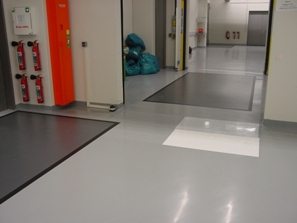
Contamination control is the generic term for all activities aiming to control the existence, growth and proliferation of contamination in certain areas. Contamination control may refer to the atmosphere as well as to surfaces, to particulate matter as well as to microbes and to contamination prevention as well as to decontamination.
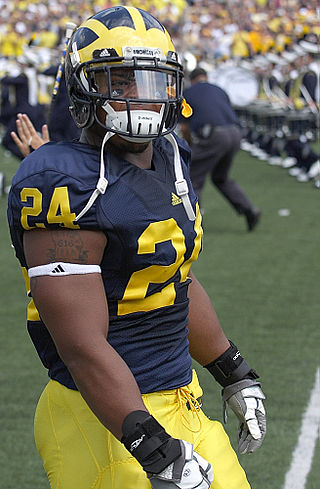
Protective equipment in gridiron football consists of equipment worn by football players for the protection of the body during the course of a football game. Basic equipment worn by most football players include helmet, shoulder pads, gloves, shoes, and thigh and knee pads, a mouthguard, and a jockstrap or compression shorts with or without a protective cup. Neck rolls, elbow pads, hip pads, tailbone pads, rib pads, and other equipment may be worn in addition to the aforementioned basics. Football protective equipment is made of synthetic materials: foam rubbers, elastics, and durable, shock-resistant, molded plastic. Football protective equipment has remained consistent in use for decades with some slight modifications made over the years in design and materials. The assignment and maintenance of football gear belongs to the team equipment manager.

Scrubs, or sometimes Surgical Scrubs, or Nursing Scrubs, are the sanitary clothing worn by physicians, nurses, dentists and other workers involved in patient care. Originally designed for use by surgeons and other operating room personnel, who would put them on when sterilizing themselves, or "scrubbing in", before surgery, they are now worn by many hospital personnel.
The Medieval period in England is usually classified as the time between the fall of the Roman Empire to the beginning of the Renaissance, roughly the years AD 410–1485. For various peoples living in England, the Anglo-Saxons, Anglo-Danes, Normans and Britons, clothing in the medieval era differed widely for men and women as well as for different classes in the social hierarchy. The general styles of Early medieval European dress were shared in England. In the later part of the period, men's clothing changed much more rapidly than women's styles. Clothes were very expensive and both the men and women of lower social classes continued also divided social classes by regulating the colors and styles these various ranks were permitted to wear. In the early Middle Ages, clothing was typically simple and, particularly in the case of lower-class peoples, served only basic utilitarian functions such as modesty and protection from the elements. As time went on the advent of more advanced textile techniques and increased international relations, clothing gradually got more and more intricate and elegant, even with those under the wealthy classes, up into the renaissance.

Prevention of viral hemorrhagic fever is similar for the different viruses. There are a number of different viral hemorrhagic fevers including Ebola virus disease, Lassa fever, Rift valley fever, Marburg virus disease, Crimean-Congo haemorrhagic fever (CCHF) and yellow fever. Lassa, Ebola, Marburg and CCHF can be spread by direct contact with the body fluids of those infected. Thus the content here covers the prevention of Ebola.
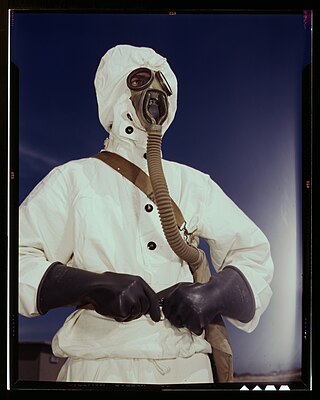
Chemical protective clothing (CPC) is clothing worn to shield those who work with chemicals from the effects of chemical hazards that can cause injuries on the job. It provides a last line of defense for chemical safety; it does not replace more proactive measures like engineering controls.

Medical gowns are hospital gowns worn by medical professionals as personal protective equipment (PPE) in order to provide a barrier between patient and professional. Whereas patient gowns are flimsy often with exposed backs and arms, PPE gowns, as seen below in the cardiac surgeon photograph, cover most of the exposed skin surfaces of the professional medics.



















